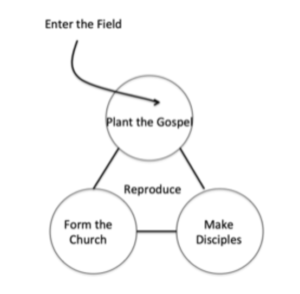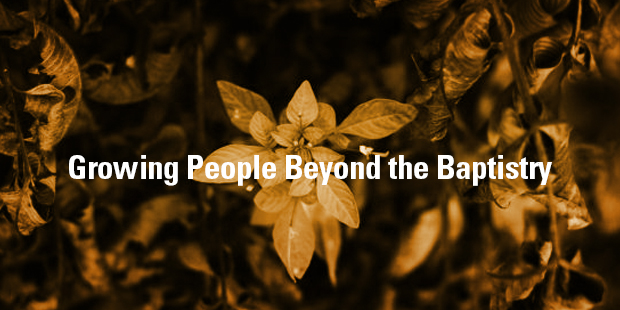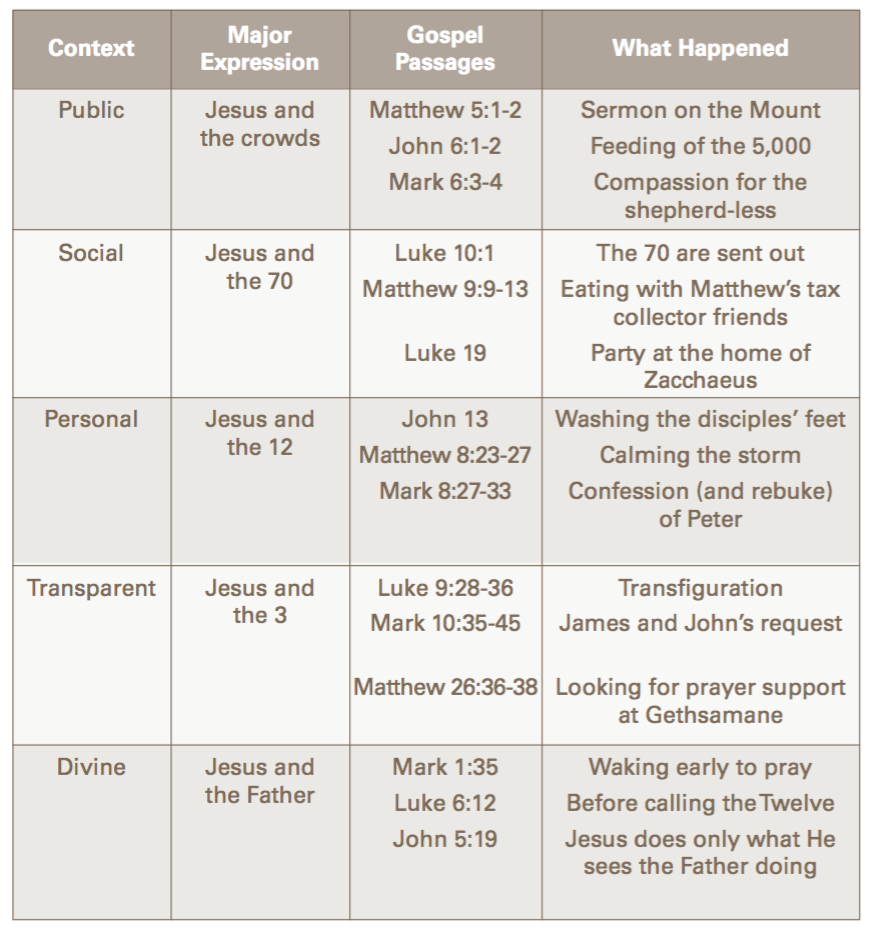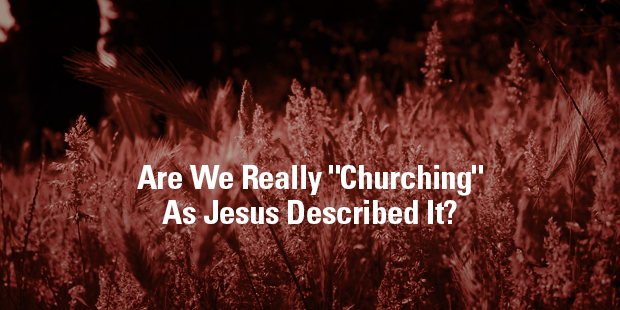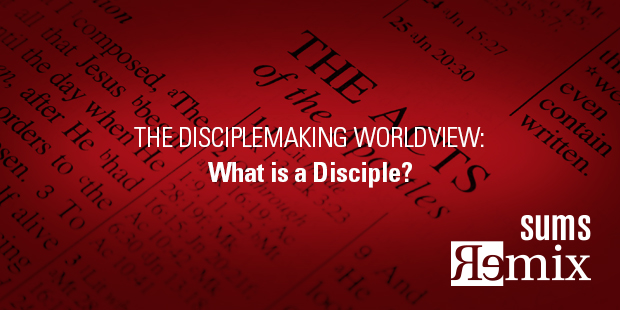
The Disciplemaking Worldview: What is a Disciple?
Auxano Navigator David Putman is committed to catalyzing gospel-centered, disciple-making movements. He lives out his mission by helping others go further, faster, and longer than they ever imagined. David’s writings have been the primary foundation of this SUMS Remix.
According to David, disciple making at its core is about worldview transformation. A person’s worldview is the way they see and understand the world. Our worldview is based on our core beliefs. These non-negotiable beliefs determine our behavior. In other words, what we believe determines our behavior.
As a disciple of Christ we might frame it this way, “What we believe about the gospel determines how we follow Jesus.”
David uses a simple tool he created called the “Gospel Lens” to illustrate this. This tool is based on three questions that he believes have a very unique and specific relationship to one another.
It is essential that we begin with the gospel, move to disciple, and finally to the church in the order we ask and answer these questions. In other words, the gospel informs our understanding of disciples, and our understanding of disciples informs our understanding of the church.
What is a Disciple?
THE QUICK SUMMARY – A Long Obedience in the Same Direction by Eugene Peterson
As a society, we are no less obsessed with the immediate than when Eugene Peterson first wrote this Christian classic. If anything, email and the Internet may have intensified our quest for the quick fix. But Peterson’s time-tested prescription for discipleship remains the same–a long obedience in the same direction.
Tucked away in the Hebrew Psalter, Peterson discovered “an old dog-eared songbook,” the Songs of Ascents that were sung by pilgrims on their way up to worship in Jerusalem. In these songs (Psalms 120-134) Peterson finds encouragement for modern pilgrims as we learn to grow in worship, service, joy, work, happiness, humility, community and blessing. This 20th anniversary edition of A Long Obedience in the Same Direction features these Psalms in Peterson’s widely acclaimed paraphrase, The Message. He also includes an epilogue in which he reflects on the themes of this book and his ministry during the twenty years since its original publication.
A SIMPLE SOLUTION
The announcement of good news is that God in Christ doesn’t only save us by grace, but He grows us by grace. We see this best in Jesus’ parable of the growing seed. He also said, “This is what the kingdom of God is like. A man scatters seed on the ground. Night and day, whether he sleeps or gets up, the seed sprouts and grows, though he does not know how. All by itself the soil produces grain – first the stalk, then the head, then the full kernel in the head. As soon as the grain is ripe, he puts the sickle to it, because the harvest has come” (Mark 4:26-29, NIV). The seed in this parable is the gospel and soil is our hearts. When we receive the seed into the good soil of our heart something happens. We can’t explain it, but it does. Jesus says, “Night and day, whether he sleeps or gets up, the seed sprouts and grows, though he does not know how.” This is an amazing truth that changes everything; gospel in, gospel out.
Paul understood this when he said, “Therefore, I urge you, brothers, in view of God’s mercy to offer your bodies as living sacrifices, holy and pleasing to God – this is your spiritual act of worship. Do not be conformed any longer to the pattern of this world, but be transformed by the renewal of your mind. Then you will be able to test and approved what God’s will is – his good, pleasing, and perfect will” (Romans 12:1-2, NIV). In this text Paul demonstrates that our devotion is based on our understanding of the gospel. We are to offer our bodies, but only as a result of being in full view of His mercy. We don’t present our bodies to get God’s mercy; we present our bodies because of God’s mercy. The order has been reversed. I don’t do in order to earn God’s favor, but I do because I have God’s favor. He goes on and addresses the idea of transformation. We are transformed by the renewal of our minds. Once again we see gospel in, gospel out.
When I come to understand that I am fully loved, then and only then can I offer love. When I come to understand God’s forgiveness of me, I become more forgiving and understanding of others. As I come to understand God’s provision for me, only then can I truly become more generous. As I come to apprehend the gospel there is a reformatting and aligning of my values that take place. I am transformed.
When you understand gospel in, gospel out it changes everything.
It is not difficult in our world today to get a person interested in the message of the gospel; it is terrifically difficult to sustain the interest.
Millions of people in our culture make decisions for Christ, but there is a dreadful attrition rate. Many claim to have been born again, but the evidence for mature Christian discipleship is slim. In our kind of culture anything, even news about God, can be sold if it is packaged freshly; but when it loses its novelty, it goes on the garbage heap. There is a great market for religious experience in our world; there is little enthusiasm for the patient acquisition of virtue, little inclination to sing up for a long apprenticeship in what earlier generations of Christians called holiness.
For recognizing and resisting the stream of the world’s ways there are two biblical designations for people of faith that are extremely useful: disciple and pilgrim. Disciple (mathētēs) says we are people who spend our lives apprenticed to our master, Jesus Christ. We are in a growing-learning relationship, always. A disciple is a learner, but not in the academic setting of a schoolroom, rather at the work site of a craftsman. We do not acquire information about God but skills in faith.
Pilgrim (parepidēmos) tells us we are people who spend our lives going somewhere, going to God, and whose path for getting there is the way, Jesus Christ. We realize that “this world is not my home” and set out for “the Father’s house.”
Eugene Peterson, A Long Obedience in the Same Direction
A NEXT STEP
Auxano founder and team leader Will Mancini has developed three snapshots of Jesus’ disciple-making ministry for your consideration.
Set aside time to review each of the following snapshots, including time to read and reflect on the Scripture and how the snapshot applies to your current disciple-making process.
In each of the three synoptic gospels we see a different scene in the life of Jesus just before He calls His twelve disciples. Each snapshot reveals a unique aspect of both the heart of Jesus and His earthly-eternal kingdom strategy.
Snapshot #1: The great opportunity meets a great shortage (Matthew 9:35-38)
Before Jesus calls the twelve from Matthew’s perspective, we see Jesus’ compassion for the crowds. As He looked over the masses He observes, “the harvest is plenty but the workers are few.” His last command before selecting His inner circle is to pray earnestly to the Lord of the Harvest to send out laborers. In the light of the urgent opportunity, Jesus begins investing deeply into the twelve.
Snapshot #2: Building the infrastructure not the popularity (Mark 3:7-12)
Mark shows us a different angle of Jesus’ motive just before He appoints the twelve. In this passage He repeats the phrase “great crowd” showing for the first time the sheer volume of people who were responding to Jesus. Not only that, He shows the intensity of their pursuit by explaining how the people were “pressing around him” and how they needed to escape in a boat “lest they be crushed.” If that wasn’t enough, even the demons cried out that He was the Son of God. What was Jesus’ final act before appointing the twelve from Mark’s perspective? Jesus strictly ordered them NOT to make Him known.
Why in the world did Jesus come to earth if He wanted to lower the volume of His identity and mission? Why would He intentional minimize His platform? The answer is simple. He wasn’t building a stage and an audience; He was building a people movement. And the disciple-making infrastructure was being threatened by the quick popularity. Thus He focuses even more on the twelve.
Snapshot #3: The brevity of life on earth (Luke 6:6-11)
In Luke’s snapshot we see a simple healing scene. This is where Jesus heals the man with a withered hand on the Sabbath. It is also the first time we see the scribes Pharisees filled with fury to the point that they begin plotting what they are going to do with Jesus. This is the fountainhead of the death plot that would end Jesus’ physical opportunity on planet earth to be a disciple-maker. The next thing we see Him doing is praying to the Father all night and then calling the twelve.
What about you?
As you plan the coming year, how does Jesus’ disciple-making conviction, and especially these three catalysts, rescue you from a “program management” culture? Are you herding people through classes and events? Are you trying to make life-change happen through better preaching only? Or do you have a robust, disciple-making strategy built around life-on-life investment, like Jesus?
How will your leadership and your ministry reflect the same catalysts in Jesus’ life?
- Helping people see the amazing opportunity of lost souls and recruiting them to pray for more harvest workers.
- Building the core with significant time investment before gathering the crowd.
- Being deeply aware of the finite window to invest in others in light of the eternal kingdom economy.
Excerpt taken from SUMS Remix 108-2, released December 2018.
This is part of a weekly series posting excerpts from one of the most innovative content sources in the church world: SUMS Remix book excerpts for church leaders.
SUMS Remix takes a practical problem in the church and looks at it with three solutions; each solution is taken from a different book. Additionally, a practical action step is included with each solution.
As a church leader you get to scan relevant books based on practical tools and solutions to real ministry problems, not just by the cover of the book. Each post will have the edition number which shows the year and what number it is in the overall sequence. (SUMS Remix provides 26 issues per year, delivered every other week to your inbox).
>> Subscribe to SUMS Remix <<

Tags: A Long Obedience in the Same Direction, David Putman, Discipleship, Eugene Peterson





















